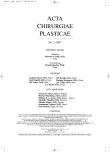VACUUM-ASSISTED CLOSURE (VAC) THERAPY IN THE MANAGEMENT OF DIGITAL PULP DEFECTS
Autoři:
K. H. Attar; D. Imran; S. Iyer
Působiště autorů:
Department of Plastic Surgery, Wexham Park Hospital, Slough, United Kingdom
Vyšlo v časopise:
ACTA CHIRURGIAE PLASTICAE, 49, 3, 2007, pp. 75-76
CASE REPORT
A 46-year-old male gardener of African origin presented with increasing pain and swelling of his left (non-dominant) thumb two weeks after a thorn prick injury. Examination showed an infected and necrotic pulp space with no clinical or radiological evidence of osteomyelitis.
Necrotic skin and fat were debrided at two short-spaced procedures. This left the patient with a large defect in the thumb pulp measuring 2 x 1.5 cm (Fig. 1) with exposed flexor pollicis longus insertion.

After the debridement procedures, once the wound was observed to be clean, a vacuum-assisted closure foam was cut to adjust the size of the defect and applied with an airtight dressing (Fig. 2). The suction tube of the dressing was connected to the pump for a total period of four days with continuous application of a negative pressure of 100 mmHg.

Marked proliferation of healthy granulation tissues was noticed at the base of the wound, filling the defect and covering the exposed tendon. The wound was subsequently dressed with a non-sticky, moist dressing to allow epithelialization and mobilization exercises were continued during the whole process. Two weeks after the initial treatment, good functional and cosmetic results (Fig. 3) were observed. The sensory recovery was 2 mm of moving two-point discrimination and the range of movement was full at the interphalangeal joint.

DISCUSSION
Vacuum-Assisted Closure (VAC), also known as negative wound pressure therapy, is a modern technique designed to induce and promote wound healing. The technique is based on defined, controlled negative pressure application via foam dressing to wound surfaces. The vacuum system encourages faster granulation tissue formation, removal of excessive exudates, enhanced blood flow in the wound and attraction of the borders of the wound to the centre (2). The technique has been successfully used in the treatment of various types of soft tissue injuries including degloving injuries, infected sternotomy wounds, and various soft tissue injuries prior to surgical closure, grafting or reconstructive surgery (1).
The practice of exposing a wound to sub-atmospheric pressure to promote debridement and healing was first described following the successful use of this technique in patients with open fractures (3). Over the following years, the technique acquired a good reputation in the management of acute and chronic wounds including pressure sores, diabetic ulcers, venous ulcers, surgical traumatic wounds and radiated wounds.
A wide range of procedures is currently used to treat digital pulp defects. Depending on the extent of the defect, treatment can vary from dressings with healing by secondary intention to split- or full-thickness graft, cross finger flap, homodigital flap, thenar flap, neurovascular flap or even toe pulp transfer (4).
Compared to other conventional methods used in wound management, the advantages of vacuum-assisted closure therapy include rapid wound healing and reduced pain. The Minivac apparatus with which the patient can be discharged home has further advantage of shorter hospital stays, lower medical costs and fewer nursing responsibilities (6). Complications associated with VAC therapy have been minor and largely technical in nature. Erosion of surrounding tissue, maceration of skin, excessive in-growth of granulation tissue into the foam dressing, and pain are among the most common complications found with this therapy (5).
In this article, we described our initial experience with the VAC therapy in treating thumb pulp defects. This had a satisfactory outcome. To our knowledge, this is the first report in literature describing the use of vacuum-assisted closure therapy for this purpose. We propose this technique for the management of digital pulp defects.
Address for correspondence:
Kaka Hama Attar MRCS
395A Hale End Road
Woodford Green
Essex IG8 9LL
United Kingdom
E-mail: hamaattar@yahoo.co.uk
Zdroje
1. Avery C., Pereira J., Moody A., Whitworth I. Clinical experience with the negative pressure wound dressing. Br. J. Oral Maxillofac. Surg., 38, 2000, p. 343–345.
2. Ferreira MC., Wada A., Tuma JP. The vacuum assisted closure of complex wounds: report of 3 cases. Rev. Hosp. Clin. Fac. Med. Sao Paulo, 58, 2003, p. 227–230.
3. Fleischmann W., Strecker W., Bombelli M., Kinzl L. Vacuum sealing as treatment of soft tissue damage in open fractures. Unfallchirurg, 96, 1993, p. 488–492.
4. Guelmi K., Barbato B., Maladry D., Mitz V., Lemerle JP. Reconstruction of digital pulp by pulp tissue transfer of the toe. Apropos of 15 cases. Rev. Chir. Orthop. Reparatrice. Appar. Mot., 82, 1996, p. 446–452.
5. Susan ME. Negative pressure wound therapy. Plast. Surg. Nurs., 18, 1998, p. 27–35.
6. Tzeng YJ., Hung CC., Hsieh YM., Han CY. Using vacuum-assisted closure (VAC) in wound management. Hu. Li. Za. Zhi., 51, 2004, p. 79–83.
Štítky
Chirurgie plastická Ortopedie Popáleninová medicína TraumatologieČlánek vyšel v časopise
Acta chirurgiae plasticae

2007 Číslo 3
- Metamizol jako analgetikum první volby: kdy, pro koho, jak a proč?
- Neodolpasse je bezpečný přípravek v krátkodobé léčbě bolesti
- Léčba akutní pooperační bolesti z pohledu ortopeda
Nejčtenější v tomto čísle
- VACUUM-ASSISTED CLOSURE (VAC) THERAPY IN THE MANAGEMENT OF DIGITAL PULP DEFECTS
- GRAFTING POSTERIOR TIBIAL NERVE WITH IPSILATERAL SURAL NERVE CABLES IN LEG REPLANTATION – A COMMON SENSE APPROACH
- BILATERAL CHEEK-TO-NOSE ADVANCEMENT FLAP: AN ALTERNATIVE TO THE PARAMEDIAN FOREHEAD FLAP FOR RECONSTRUCTION OF THE NOSE
- UNEXPECTED ULNAR NERVE SCHWANNOMA. THE REASONABLE RISK OF MISDIAGNOSIS
